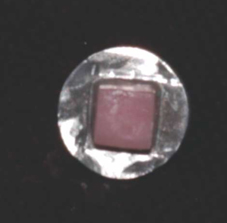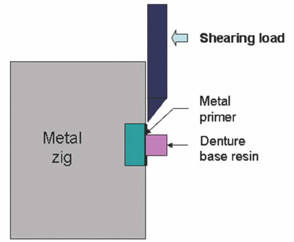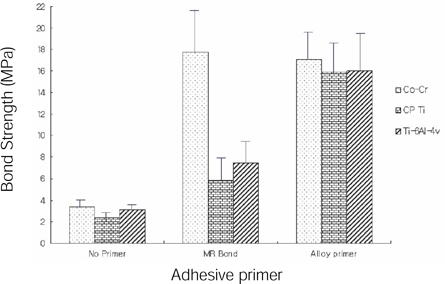J Adv Prosthodont.
2009 Mar;1(1):41-46. 10.4047/jap.2009.1.1.41.
Effect of adhesive primers on bonding strength of heat cure denture base resin to cast titanium and cobalt-chromium alloy
- Affiliations
-
- 1Department of Prosthodontics, Graduate School, Chonnam National University, Gwang-Ju, Korea. msvang@chonnam.ac.kr
- KMID: 2176342
- DOI: http://doi.org/10.4047/jap.2009.1.1.41
Abstract
- STATEMENT OF PROBLEM: The poor chemical bonding of a denture base resin to cast titanium framework often introduces adhesive failure and increases microleakage. PURPOSE: This study evaluated the shear bond strengths of a heat cure denture base resin to commercially pure titanium, Ti-6Al-4V alloy and a cobalt-chromium alloy using two adhesive primers. MATERIAL AND METHODS: Disks of commercially pure titanium, Ti-6Al-4V alloy and a cobalt-chromium alloy were cast. Specimens without the primer were also prepared and used as the controls. The shear bond strengths were measured on a screw-driven universal testing machine. RESULTS: The primers significantly (P < .05) improved the shear bond strengths of the heat cure resin to all metals. However, the specimens primed with the Alloy primer(R) (MDP monomer) showed higher bond strength than those primed with the MR bond(R) (MAC-10 monomer) on titanium. Only adhesive failure was observed at the metal-resin interface in the non-primed specimens, while the primed specimens showed mixed failure of adhesive and cohesive failure. CONCLUSIONS: The use of appropriate adhesive metal primers makes it possible not only to eliminate the need for surface preparation of the metal framework before applying the heat cure resins, but also reduce the need for retentive devices on the metal substructure. In particular, the Alloy primer(R), which contains the phosphoric acid monomer, MDP, might be clinically more acceptable for bonding a heat cure resin to titanium than a MR bond(R), which contains the carboxylic acid monomer, MAC-10.
MeSH Terms
Figure
Reference
-
1. Jacobson TE, Chang JC, Keri PP, Watanabe LG. Bond strength of 4-META acrylic resin dentrue base to cobalt chromium alloy. J Prosthet Dent. 1988. 60:570–576.2. Jacobson TE. The significance of adhesive denture base resin. Int J Prosthodont. 1989. 2:163–172.3. Dunny JA, King GE. Minor connector disigns for anterior acrylic resin bases; a preliminary study. J Prosthet Dent. 1975. 34:496–502.4. Brown DT, Desjardins RP, Chao EY. Fatigue failure in acrylic resin retaining minor connectors. J Prosthet Dent. 1987. 58:329–335.5. Sasaki M, Yasuda N, Mogi T, Ai M. Influence between metal and resin on the finishing line of cobalt-chromium denture. Part 3. Studies on finishing line structure. J Jpn Prosthodont Soc. 1994. 38:191–197.6. Yasuda N, Sasaki M, Mogi T, Ai M, Nakabayashi N. Influence between metal and resin on the finishing line of cobalt-chromium denture. Part 2. Effect of 4-META on preventing dye penetration at the finishing line. J Jpn Prosthodont Soc. 1978. 22:761–765.7. Yasuda N, Sasaki M, Shinogaya T, Ai M, Nakabayashi N. Influence between metal and resin on the finishing line of cobalt-chromium denture. Part 7. A clinical evaluation of 4-META system : a five-year report. J Jpn Prosthodont Soc. 1985. 29:761–765.8. Kononen M, Rintanen J, Waltimo A, Kempainen P. Titanium framework removable partial denture used for patients allergic to other metals: a clinical report and literature review. J Prosthet Dent. 1995. 73:4–7.9. Fujishima A, Fujimori S, Tamaki Y, Miyazaki T, Fujishima Y, Shiba A. A basic study on the fabrication of titanium veneered crown with resin composites. (Part 2). Effect of surface treatments on bonding of resin composites. (Part 2). Effect of surface treatment on bonding of resin composites with titanium. J Jpn Dent Mater. 1995. 14(special issue):78–79.10. Hansson O. Strength of bond with Comspan Opaque to three silicoated alloys and titanium. Scand J Dent Res. 1990. 98:248–256.11. Fujishima A, Fujishima Y, Ferracane JL. Shear bond strength of four commercial bonding systems to cp Ti. Dent Mater. 1995. 11:82–86.12. Yoshida N. Clinical application of resin facing titanium crown by the non-retention method-bond strength of composite resin materials for veneering to titanium. Ohu Dent J. 1997. 24:1–20.13. Hansson O, Moberg LE. Evaluation of three silicoating methods for resin-bonded prostheses. Scand J Dent Res. 1993. 101:243–251.14. Kern M, Thompson VP. Durability of resin bonds to pure titanium. J Prosthodont. 1995. 4:16–22.15. Kurtz K, Kabcenell J, Watanabe I, Okabe T. Shear bond strength of polymer-glass to cast titanium. J Dent Res. 1998. 77:272. Abstract 1331.16. Yamauchi M, Sakai M, Kawano J. Clinical application of pure titanium for cast plate dentures. Dent Mater J. 1988. 7:39–47.17. Matsumura H, Kojima K, Kadoma Y, Masuhara E. Studies on dental self-curing resins (26). Effect of 4-META and 4-MET addition to the MMA-TBBO resin. Shika Zairyo kikai. 1984. 3:480–489. [in Japanese].18. Yoshida K, Taira Y, Matsumura H, Atsuta M. Effect of adhesive metal primers on bonding a prosthetic composite resin to metals. J Prosthet Dent. 1993. 69:357–362.19. Kojima K, Kadoma Y, Imai Y. Adhesion to precious metals utilizing triazine dithione derivative monomer. J Jpn Soc Dent Mater Devices. 1987. 6:702–707.20. May KB, Russell MM, Razzoog ME, Lang BR. The shear strength of polymethyl methacrylate bonded to titanium partial denture framework material. J Prosthet Dent. 1993. 70:410–413.21. May KB, Fox J, Razzoog ME, Lang BR. Silane to enhance the bond between polymethyl methacrylate and titanium. J Prosthet Dent. 1995. 73:428–431.22. May KB, Van Putten MC, Bow DA, Lang BR. 4-META polymethyl methacrylate shear bond strength to titanium. Oper Dent. 1997. 22:37–40.23. Shiragami N, Kozono Y, Morikawa M. Bond of resin materials to titanium. Part 1. Effects of surface treatment. J Jpn Prosthodont Soc. 1994. 88(special issue):73.24. Ohkubo C, Watanabe I, Hosoi T, Okabe T. Shear bond strengths of polymethylmethacrylate to cast titanium and cobalt-chromium frameworks using five metal primers. J Prosthet Dent. 2000. 83:50–57.25. Shimizu H, Kurtz KS, Tachii Y, Takahashi Y. Use of metal conditioners to improve bond strengths of autopolymerizing denture base resin to cast Ti-6Al-7Nb and Co-Cr. J Dent. 2006. 34:117–122.
- Full Text Links
- Actions
-
Cited
- CITED
-
- Close
- Share
- Similar articles
-
- BOND STRENGTH BETWEEN COBALT-CHROMIUM ALLOY AND DENTURE BASE RESIN ACCORDING TO ADHESIVE PRIMERS
- The Effects Of Thermocycling On The Bond Strength Between Cobalt-Chromium Alloy And Denture Base Resin
- The effect of Zirconium Nitride coating on shear bond strength with denture base resin in Co-Cr alloy and titanium alloy
- A STDUY ON THE SURFACE MORPHOLOGY AND BOND STRENGTH OF DENTURE BASE RESIN TO COBALT-CHROMIUM ALLOY AFTER VARYING MODES OF SURFACE TREATMENT
- A comparison study on shear bond strength of 3D printed resin and conventional heat-cured denture base resin to denture relining materials







